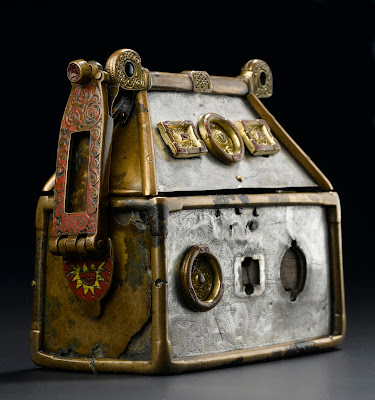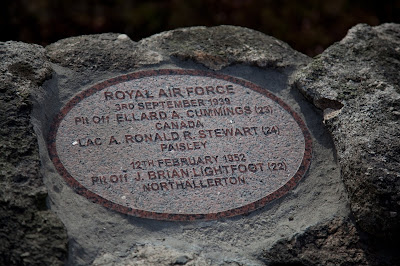BLOODY MONYMUSK - by Duncan Harley
In the August of 2014 Edinburgh Auctioneers Lyon & Turnbull offered for
sale a small decorative wooden box believed to be the work of Alexander J.
Brook of Edinburgh silversmiths Brook & Sons. Brook was known for his
meticulously researched reproductions of antiquarian items and the small (W
112mm x D 51mm x H 89mm) highly decorated, silver plated wooden casket would
have presented few challenges for him.
Brook’s 19th century replica was of an item known as the Monymusk Reliquary.
The unsigned piece had been valued at between £5000-10,000 however, perhaps due to interest in all things Scottish generated during the run up to the Scottish Referendum and the approaching 700th anniversary of the Battle of Bannockburn, the tiny silver panelled yew wood container fetched a staggering £20,000 on sale-day.
A strange prequel to the sale had of course been played out some 79 years before, in 1933, when the original Monymusk Reliquary had been advertised for sale by auction in a London saleroom.
According to National Museums Scotland, who now hold the circa 8th century reliquary in their permanent collection, “Portable reliquaries were carried on campaign with the Scottish army” and the Monymusk Reliquary “is thought to have been the so called Brechbennoch of St Columba which was with the army at the Battle of Bannockburn in 1314.” Widely supposed to have once contained a holy relic of St Columba, the Brechbennoch, was regarded as a sort of good luck charm on the battlefield and was carried - probably on a leather halter around the neck of its keeper - at the head of the Scottish army as a sacred battle ensign.
The tale of how the reliquary came into the care of the National Museums Scotland is a strange one.
King William the Lion had founded the great abbey at Arbroath partly in memory of Thomas a’ Becket, a friend since childhood, who had been murdered in 1170 while praying within Canterbury Cathedral. Among the gifts bestowed by the king at the time of the establishment of the abbey were church lands at Forglen just outside Turriff.
Along with the lands came the Brechbennoch and, although there is mystery regarding its earlier history, King William made a point of gifting the precious object to the abbey along with an obligation that it should be carried into battle ahead of the Scottish army by the guardians of the abbey. In 1315, some seven months after Bernard de Linton the abbot at Arbroath had carried the reliquary into battle at Bannockburn, he passed on the somewhat dangerous responsibility to Malcolm of Monymusk along with the lands at Forglen as a sweetener in the deal.
The reliquary seems to have moved back to Aberdeenshire along with the Forglen title deeds and there it seemingly remained until 1933 when the precious relic turned up in that London auction house.
In the meantime, it is widely supposed to have resided at the at Monymusk Priory until a disastrous fire in 1554 resulted in its removal to nearby Monymusk House. Latterly Monymusk House was the domain of the Grants and a concerned Scottish nation were mobilised both by the press of the day but also by the efforts of Graham Callander then head of the national museum of Scotland, who took the view that the Brechbennoch of St Columba rightly belonged to the Scottish nation.
Callander, aided by a group of influential friends, took in hand the task of raising the necessary money to purchase the relic and politicians such as Prime Minister Sir Ramsay Macdonald became involved. Seemingly even the queen became interested in the affair and she was rumoured to have visited the saleroom.
After furious debate, both in the press and in the English parliament, as to the right of the Laird at Monymusk to sell the much-venerated relic, the item was withdrawn from the saleroom and following an agreement with the heir to the estate it was acquired for the Scottish nation and is today part of the national collection.
Brook’s 19th century replica was of an item known as the Monymusk Reliquary.
The unsigned piece had been valued at between £5000-10,000 however, perhaps due to interest in all things Scottish generated during the run up to the Scottish Referendum and the approaching 700th anniversary of the Battle of Bannockburn, the tiny silver panelled yew wood container fetched a staggering £20,000 on sale-day.
A strange prequel to the sale had of course been played out some 79 years before, in 1933, when the original Monymusk Reliquary had been advertised for sale by auction in a London saleroom.
According to National Museums Scotland, who now hold the circa 8th century reliquary in their permanent collection, “Portable reliquaries were carried on campaign with the Scottish army” and the Monymusk Reliquary “is thought to have been the so called Brechbennoch of St Columba which was with the army at the Battle of Bannockburn in 1314.” Widely supposed to have once contained a holy relic of St Columba, the Brechbennoch, was regarded as a sort of good luck charm on the battlefield and was carried - probably on a leather halter around the neck of its keeper - at the head of the Scottish army as a sacred battle ensign.
The tale of how the reliquary came into the care of the National Museums Scotland is a strange one.
King William the Lion had founded the great abbey at Arbroath partly in memory of Thomas a’ Becket, a friend since childhood, who had been murdered in 1170 while praying within Canterbury Cathedral. Among the gifts bestowed by the king at the time of the establishment of the abbey were church lands at Forglen just outside Turriff.
Along with the lands came the Brechbennoch and, although there is mystery regarding its earlier history, King William made a point of gifting the precious object to the abbey along with an obligation that it should be carried into battle ahead of the Scottish army by the guardians of the abbey. In 1315, some seven months after Bernard de Linton the abbot at Arbroath had carried the reliquary into battle at Bannockburn, he passed on the somewhat dangerous responsibility to Malcolm of Monymusk along with the lands at Forglen as a sweetener in the deal.
The reliquary seems to have moved back to Aberdeenshire along with the Forglen title deeds and there it seemingly remained until 1933 when the precious relic turned up in that London auction house.
In the meantime, it is widely supposed to have resided at the at Monymusk Priory until a disastrous fire in 1554 resulted in its removal to nearby Monymusk House. Latterly Monymusk House was the domain of the Grants and a concerned Scottish nation were mobilised both by the press of the day but also by the efforts of Graham Callander then head of the national museum of Scotland, who took the view that the Brechbennoch of St Columba rightly belonged to the Scottish nation.
Callander, aided by a group of influential friends, took in hand the task of raising the necessary money to purchase the relic and politicians such as Prime Minister Sir Ramsay Macdonald became involved. Seemingly even the queen became interested in the affair and she was rumoured to have visited the saleroom.
After furious debate, both in the press and in the English parliament, as to the right of the Laird at Monymusk to sell the much-venerated relic, the item was withdrawn from the saleroom and following an agreement with the heir to the estate it was acquired for the Scottish nation and is today part of the national collection.
If you have enjoyed this extract from my recent book –
The Little History of Aberdeenshire, then please consider purchasing a copy
from your local bookshop or from Amazon. Or you can borrow for free from both
Aberdeen City Library or Aberdeenshire Library Service.
ISBN: 9780750989299
Published by The History Press @ £12 in hardback and available from Amazon.











Comments
Post a Comment